Main page <> Index of descriptions <> Previous description <> Penicillium <> Next description
Penicillium
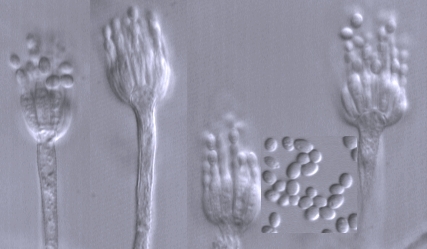
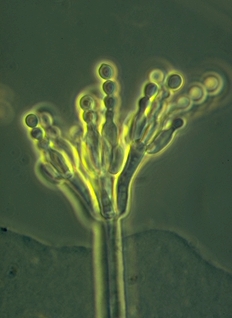
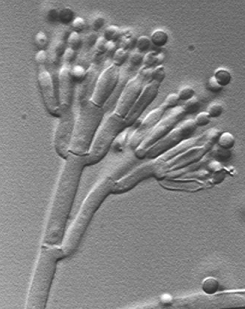
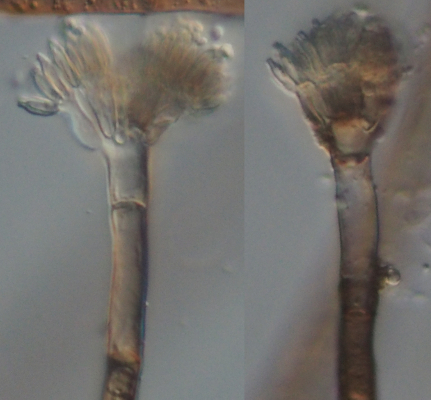
Species of Penicillium are recognized by their dense brush-like spore-bearing structures called penicilli (sing.: penicillus). The conidiophores are simple or branched and are terminated by clusters of flask-shaped phialides. The spores (conidia) are produced in dry chains from the tips of the phialides, with the youngest spore at the base of the chain, and are nearly always green. Branching is an important feature for identifying Penicillium species. Some, such as Penicillium glabrum leftmost pictures in the top row, are unbranched and simply bear a cluster of phialides at the top of the stipe. Others (middle photo) may have a cluster of branches, each bearing a cluster of phialides. Penicillum atramentosum, at right, represents a third type having branches that bear a second order of branches, bearing in turn a cluster of phialides. These three types of spore bearing systems (penicilli) are called monoverticillate, biverticillate and terverticillate respectively. Penicillium is a large and difficult genus encountered almost everywhere, and usually the most abundant genus of fungi in soils.
Some species of Penicillium reproduce sexually by means of asci and ascospores produced within small stony stromata. These teleomorphs were the basis for the separate genus Eupenicillium, now no longer in use. See the discussion of the Eurotiales for an illustration of one of these.
The two pictures at left deserves separate mention. Although clearly biverticillate, the large dark conidiophores (stalks) are not at all typical for species of Penicillium. This species, P. glaucoalbidum, is charactaristically found growing out of fallen conifer needles. It is so unlike other species of Penicillium that it was long-known under the name Thysanophora penicillioides and was only recently shown by nucleic acid sequencing to belong in Penicillium.
Species of the genus Talaromyces produce anamorphs very similar to those of Penicillium species. In fact the two genera may be quite difficult to tell apart at times. However, Talaromyces species usually produce rather compact and highly symmetrical penicilli bearing long lance-like phialides and often rather pointed conidia. Many produce yellow hyphae that may characterize the whole colony. The teleomorphs of Talaromyces species are loose and hyphal rather than stony like those of Penicillium species.
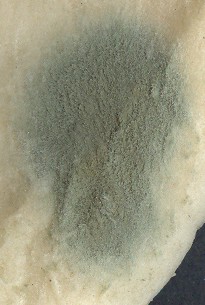
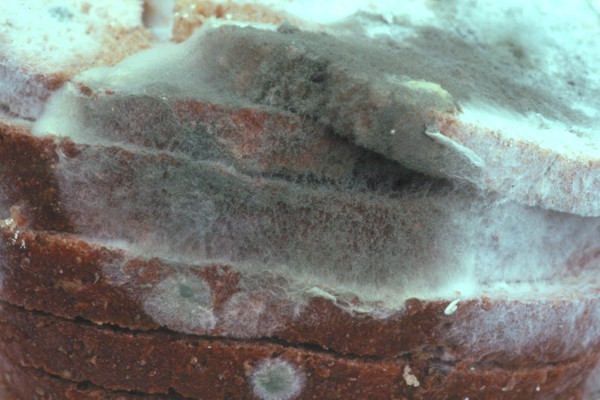
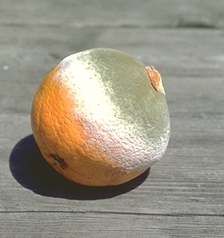
The common occurrence of Penicillium species in food is a particular problem. Some species produce toxins and may render food inedible or even dangerous. It is a good practice to discard foods showing the development of any mould. On the other hand some species of Penicillium are beneficial to humans. Cheeses such as Roquefort, Brie, Camembert, Stilton, etc. are ripened with species of Penicillium and are quite safe to eat. The drug penicillin is produced by Penicillium chrysogenum, a commonly occurring mould in most homes.
Classification: Aspergillaceae (Eurotiales). Ref: Kulik 1968; Pitt, 1980, 1985; Raper and Thom 1949; Ramirez, 1982; Samson and Frisvad, 2004; Samson and Houbraken, 2011; Samson, Stolk, and Hadlok 1976; Stolk and Samson, 1972, 1983